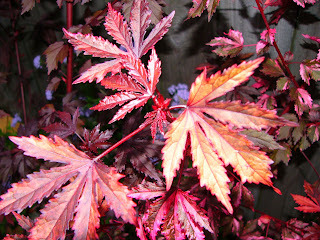Busy busy busy busy busy. Holidays good. But, busy.
Since the weather getting a little cooler I've been trying to catch up with the garden for all the hours missed from the heat wave. So, I was outside for 4 hours yesterday chugging away, unfortunately not during the wee hours of the morning as I usually like, but I started at noon because from morning until then I was curled up in bed with a ridiculous tummy ache from eating 6 plums and 3 peaches (all delicious btw) from the 20 pounds of fruit the husband and I picked from out local Jones Orchard ($0.89/lb for peaches, nectarines and plums!) (but unless I turn them into jam fast, they need to be devoured!). Needless to say, my stomach protesteths at that much acidity and told me so.
Thus partly the reason why I didn't get to my regularly scheduled posting.
So, I am attempting to combine yesterday's planned leaf lesson with pictures for today as scheduled.
I really am interested in learning the horticulture terminology of leaves (and eventually flowers, fruits, roots and etc) because I (1) like knowing what the heck all those scientific papers are talking about when describing leaves especially on websites that talk about specific plant anatomy and I can't get a clear idea of what the plant looks like and (2) it makes for plant identification easier when you can use formal terms rather than descriptors such as "sort of zig-zaggy but curved and hairy...."
Leaf morphology is broken down in 3 sections: Shape (of one leaf/the leaf set), Margin (what the edge of the leaf looks like), and finally Venation (how the leaf veins are laid out).
There is a great diversity in leaf shape, which I was aware of but didn't realize all the subtleties until I encountered the leaf chart in the link below. Because of the diversity of simply leaf shapes I'll be focusing on shape in this entry rather than margins and venation.
This very handy leaf chart on wikimedia (you can blow it up to an easier to read size) is wonderfully detailed and I will only address and give examples of common leaf shapes/margins/venations that a person might encounter and those in my garden that I can show examples of.
Some common leaf shapes include acicular, rhomboid, lanceolate, linear, cordate, obtuse, deltoid, pinnatisect, elliptic.
The nice leaf chart explains beneath each of these names the characteristic of these names.
Acicular literally does mean needle shaped and those with that shaped leaves include many conifers such as firs, pines and some junipers.
Rhomboid shaped leaves are fairly common and an many trees exhibit this basic diamond leaf shape.
Lanceolate leaves are reminiscent the spearheads of lances, pointed at both ends, (but also a similar to those of the ensiformis shape which are thinner and pointier than wider in middle lanceolates) can be found in many types of grasses and daylilies.
(lemongrass, chilling in my tub. Pardon if these are old images, didn't have new ones on hand)
Linear leaves are as they sound, like lines and are single leaves with long even edges such as those of chives.
Cordate leaves are heart shaped (cord- being the Latin term for heart) and an example of a leaf of this shape can be seen in the redbud tree.
Obtuse leaves are blunt tipped, wide leaves such as those seen in smoke trees from the genus Continus.
Deltoid leaves like the muscles of your shoulder area are triangular such as those of aspens.
Pinnatisect leaves are often seen and vilified by those who enjoy perfect lawns, but enjoyed by gourmet salad eaters as commonly seen pinnatisect leaves can be seen in dandelions! Pinna-is Latin for feather with -sect meaning "to cut." These leaves are deeply cut up to the leaf's midrib. Many ferns that do not exhibit separate leaflets fall into this leaf category.
(do not pay attention to the mutated 2 headedness of this dandelion, please take note of the pinnatisect leaves!)
Elliptic leaves, just like rhomboid leaves are fairly common in many plants and trees. Some examples of these sorts of leave are citrus, apple and some viburnums.
(many, many elliptic leaves on a citrus tree)
The former are all very common leaves and while walking about my garden some more very interesting leaf shapes can be seen:
Tripinnate leaves, where there are multiple leaflets on one stem can be seen on a rue plant
Spatulate, or spoon shaped leaves like loose leaf lettuce leaves
Hastate (with lobes at its base) vs Spearshaped leaves of the garden sorrel plant.
Trifolium or ternate leaves or leaflets in sets of three are not unusual, commonly seen in clover and medic, but there are freaks of nature.... such as the 'Dark Dancer' red clover variety that can often have 4 leaves!
Pedate leaves are a version of palmate type leaves except they are divided at a single point usually. Not that uncommon either like the trifoliums above, and often see in Japanese maples or are very cool like in my Haight Ashbury hibiscus:
Finally, one more unusual leaf type that I get to enjoy in my garden is the whorled kind such as sweet woodruff that I take great delight in
Another excellent leaf chart and more leaf help (with a test!) here.
Finally, leaving (ha!) you with some foliage, flowers and fruits pics:
(self seeded Grandpa Ott morning glory, love this color so much!)
(Sunny dill days!)
(Self seeded Thai basil flowers slowly opening)
(Not so much contrast here, but Fruit Basket peppers going gangbusters, so happy! These will be delicious when fully orange ripened. Self seeded tatsoi mustard greens sprouted in the basket from when I hung the seed pods to dry near the basket)
Friday, July 2, 2010
Subscribe to:
Comments (Atom)











